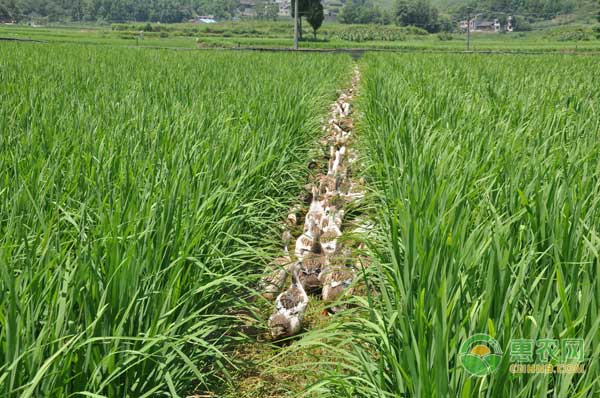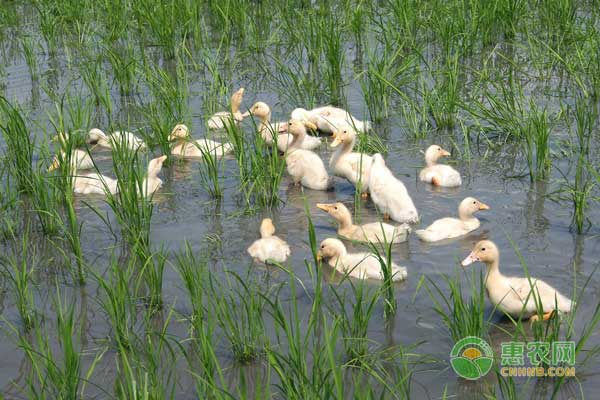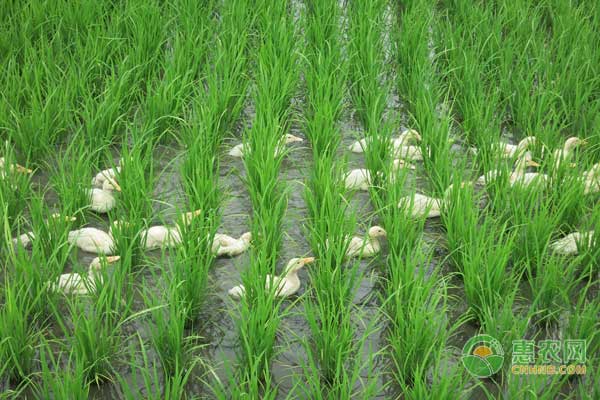What are the main points of the rice-duck farming model? I believe that the rice ducks have made this topic together, and everyone is no stranger. Because many regions have implemented this model, today we will learn a high-yield cultivation technique for raising ducks. The duck-raising rice is centered on the rice, the ducks are raised in the wild, and the rice and duck are symbiotic, achieving the purpose of harvesting and increasing the efficiency of rice and duck.

1 The choice of rice and duck farming
Rice-duck farming should be selected from the town, the environment is quieter, the shape is more square, and it is close to the water source, the water source is sufficient, and the irrigation and drainage are more convenient. The water quality of duck-raising rice should be good. The oxygen content per liter of water is above 5mg, and the pH is neutral or alkaline, which is in line with the irrigation water standards. The soil is made of clay loam. This kind of soil has strong water retention and fertility, and it is easy to manage fertilizer and water. Sandy soil, water leakage fields, generally should not be used. The area of ​​ducks in rice fields is preferably 20-30 mu.
2 Rice and duck varieties are selected
The selection of rice and duck breeds is a combination of rice and duck farming, and the basis for obtaining high yields of rice and duck raising.
Rice should be selected from the middle and late rice varieties of plant height and medium, with moderate plant-type distribution, strong stems and leaves, strong tillering ability and good resistance to stress. Such as Wuxiangyu No. 9.
Ducks should choose Shaoxing Ma Duck, Jiangsu Gaoyou Duck and Chaohu Duck, which are suitable for rice field stocking. This kind of duck has strong adaptability and small individual. The adult duck weighs about 1.25-1.5kg. It is stocked among rice plants, flexible in walking, small in food consumption and low in cost.
3 Apply enough base fertilizer
Fertilizers for raising ducks and rice fields should be applied at one time before transplanting. It is better to use long-lasting organic fertilizers and compound fertilizers. The amount of fertilizer should be determined according to the quality of the soil. The soil quality is good, and the field fertilizer should be less applied. Otherwise, the soil quality is poor. Tian thin wants more. Since the duck excrement is a good fertilizer for rice growth, the paddy rice can generally not be applied with chemical fertilizer during the growth process.

4 Rice planting should expand the plant spacing
Rice-duck farming should be carried out in dry-cultivated rice, because the seedlings of dry-breeding are hard and strong. After transplanting, the roots are green and quick, and the seedlings are not easily damaged by the ducks. It starts to be divided in about 10 days, and it is easy to achieve a balance between such seedlings and 7-10 day old ducklings.
The method of planting ducks and the basic seedlings should not only facilitate the activities of ducks in the rice groves, but also contribute to the growth of rice seedlings. Therefore, the planting method of expanding plant and thin planting should be adopted, and the plant spacing should be expanded. The general row spacing is 24-27cm, the plant spacing is 18-21cm, 1.0-1.2 million holes per mu, and the basic seedlings are 50,000-60,000. Such basic seedlings and rows of plants are conducive to the activities of ducks, and can promote early and rapid development of tillers.
5 duckling stocking should be suitable
In order to make the stocking ducks adaptable, grow fast, and have a high survival rate, it is necessary to synchronize the hatching period with the nursery period. Generally, the rice is planted and transplanted for about 30 days, and 5-7 days after transplanting, the live tree is The eggs are hatched after 28 days. When the ducklings are out of the shell, when the weight is about 150g, the ducklings have certain independent living ability. At this time, the ducklings should be trained to find water before stocking. It takes 7-10 days to cultivate indoors. It is the lived period of rice. At this time, the trained ducklings can be placed among the rice bushes and lived in the wild. This is the key to coordinating the high benefit of the fertility relationship between rice and duck.
6 Reasonable stocking of duckling density
The stocking density of ducks in the rice groves should not only consider whether the natural feed between rice can meet the fertility needs of ducks, but also consider achieving higher economic benefits. The number of stocked ducks is too high, and the food in the field will be insufficient, which will affect the growth and development of the ducks. Generally, it is appropriate to stock 20 or so per acre, and 100-120 is a group. The rice field area of ​​each group of ducks is 4-6 mu. Each duck is vaccinated before the ducklings are stocked to enhance the disease resistance of the ducklings.
7 Building a simple duck house and fence
When the ducks were just placed in the rice fields, the ducks were 7-10 years old and still relatively small. They could not stay in the paddy fields for a long time. Therefore, it is necessary to build a simple duck house on the land next to the rice fields.
The duck house is built next to the duck farm. The material of the duck house is bamboo raft and asbestos tile. The ground is covered with dry chaff and grass. The duck house is high on the side of the field. The back is low on the side, 3-4m long and 0.6-wide. 0.8m, can accommodate about 100 ducklings to inhabit and feed.
The surrounding of the simple duck house needs to be surrounded by nylon nets to ensure the safety of the ducks. Because as the duck grows up, especially after the feathers of the duck grow up, the duck will perch on the field, so the time spent in the simple shed will gradually decrease.
The fence is an important engineering facility for rice and duck farming in the field. It is the basic condition for defending natural enemies, protecting ducks and ensuring the smooth implementation of rice and duck farming.
The size of the mesh of the rice-duck-made field fence is 1-1.5, and no more than 2 fingers. The mesh is too big and the ducklings will be stuck online. It is best to use electric fences in the outer network of the rice-duck farming area, and plastic nets can be used between the fields in the area.
A net is placed inside the paddy field, and the lower end of the net must be buried in the soil and secured.
Before the ducks are placed in the rice fields, they need to have an adaptation process. It is not appropriate for the ducklings to run in the fields. To set up the initial release area, let the ducklings live in the first release area for 1-2 days, and the simple shed and the preliminary release area should be connected. In this way, the ducklings are tired in the water and will return to the simple shed to rest and forage. After 1-2 days, you can open the fence in the first release area and let the ducks go to the whole field to go to the activities.
8 Reasonably add duck feed
The ducklings are mainly artificially fed during brooding. After being placed in the paddy field, they should gradually turn to free feeding and supplement the feed properly. This will help keep the ducks with sufficient physical strength to be competent in various field management tasks and help the ducks. Establishing a good relationship with the owner is conducive to the management of the duck.
Feeding methods should be reasonably fed, avoid excessive. Generally, ducklings who have just been reared for about 10 days have poor feeding ability, and should be fed once in the morning and evening to meet the needs of early fertility. As the ducks grow up, the amount of activity and the amount of food intake are also increasing. The natural food in the rice fields can no longer satisfy the appetite of the ducks. The amount of feed supplement should be adjusted according to the growth needs of the duck.
After the rice is alive, it can be used as a fresh green fodder for raising ducks in rice fields.

9 Maintain a reasonable water layer in rice fields
Ducks are waterfowl, foraging activities in the rice, there must be a water layer in the field, generally 3-5cm water depth is appropriate, the rice field is richer in the production ditch, and the ditch always maintains a water layer 10-15cm deep, allowing the duck to Enjoy water and bathing in the water. In general, the management mode of rice-duck farming in the field is that there is always a layer of water after planting, and the rice is not placed in the field at the end of the tillering until the heading is grouted. It is usually only about 20 days before the rice harvest to drain the field.
10 Biological control of rice pests
Pests in rice fields are mainly preyed by ducks, supplemented by efficient bio-pesticide control. High-efficiency and low-toxic pesticide control in the early stage of rice leaf blast. It can be controlled by black light during the damage of the mites. These agents are not toxic to the growth and development of rice and ducks. At the same time, ducks are trampled between the rice bushes, and the pests and weeds in the field are less harmful than the average rice fields.
11 Rice ripening and duck harvest
After the rice heading, it enters the grouting stage. The ducks in the rice will eat the grain on the rice ear. Once the ducks start to eat the rice, they will no longer look for other food. Therefore, in the early stage of grouting, the ducks will be driven out of the rice fields. If it is not rushed out in time, it will affect rice yield and rice quality.
Because no pesticide is applied to the duck-raised rice fields, the amount of chemical fertilizer is extremely small. Rice-duck farming technology not only produces high-quality, pollution-free rice and duck meat, but also improves the benefits of growing rice. Therefore, it is of great significance to adjust the agricultural structure, expand the rice planting area, ensure the food supply, and promote the production technology of pollution-free rice.
The above is all the content of today. Would you like to ask the farmers, have you actually experienced this technology in person? If you have your own experience, it is recommended to share it and guide new people!
5 Lbs Xylitol Bag,Competitive Price Bulk Xylitol,Best Xylitol Sweetener Competitive,Sweetener Bulk Xylitol
Soar Biotech Co.,Ltd , https://www.xylitgum.com